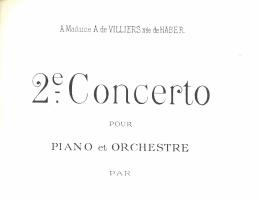Piano Concerto no. 2 op. 22
Andante sostenuto – Allegro scherzando – Presto
As one critic of the time put it, Saint-Saëns’ second piano concerto“begins with Bach and ends with Offenbach”. This pleasing quip sums up the work fairly accurately. Composed in 1868 at the request of Anton Rubinstein, who wanted to conduct a new work in Paris with Saint-Saëns as soloist, it was written in seventeen days and premiered on 13 May at the Salle Pleyel. Saint-Saëns wrote that “except for the Scherzo, which was immediately well-received, [the concerto] was not a great success; everyone agreed that the first part was incoherent and the finale a complete failure”. Perhaps the performance had been lacking in preparation... Because the work was soon so famous that, for a time, it became the most popular concerto in the world along with Grieg’s piano concerto. It is endlessly lyrical with delightful, contrasting themes and a piano part that is virtuoso without being flashy. Although the writing and textures may lack surprise, they create an overall sense of unity with consummate efficiency. The originality of the work is mainly down to its structure, which has no slow movement and follows an upward trend, from moderate to fast and from solemnity to light-heartedness. The “Andante sostenuto” opens and closes with a piano cadenza that feels like an improvisation in the style of Bach; in the middle, the piano writing recalls Chopin and one of the themes is taken from a Tantum ergo by the young Fauré (one of Saint-Saëns’ followers). Short, lively and high-spirited, the “Allegro scherzando” bears the stamp of the staccato Scherzo from Mendelssohn’s A Midsummer Night’s Dream. The final “Presto” is a heady, whirling tarantella, which seems to be more reminiscent of Chopin or Rossini than Offenbach.

